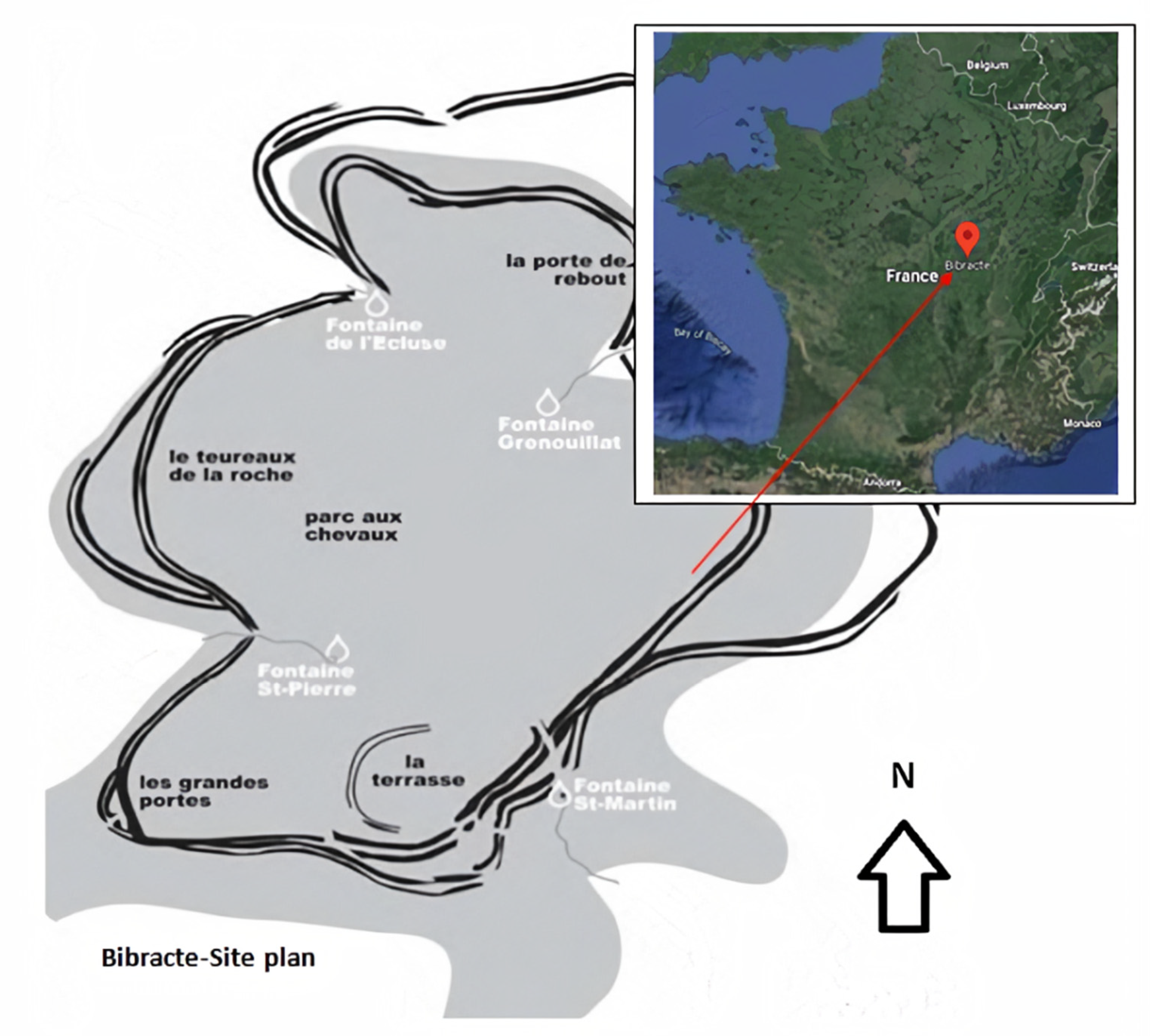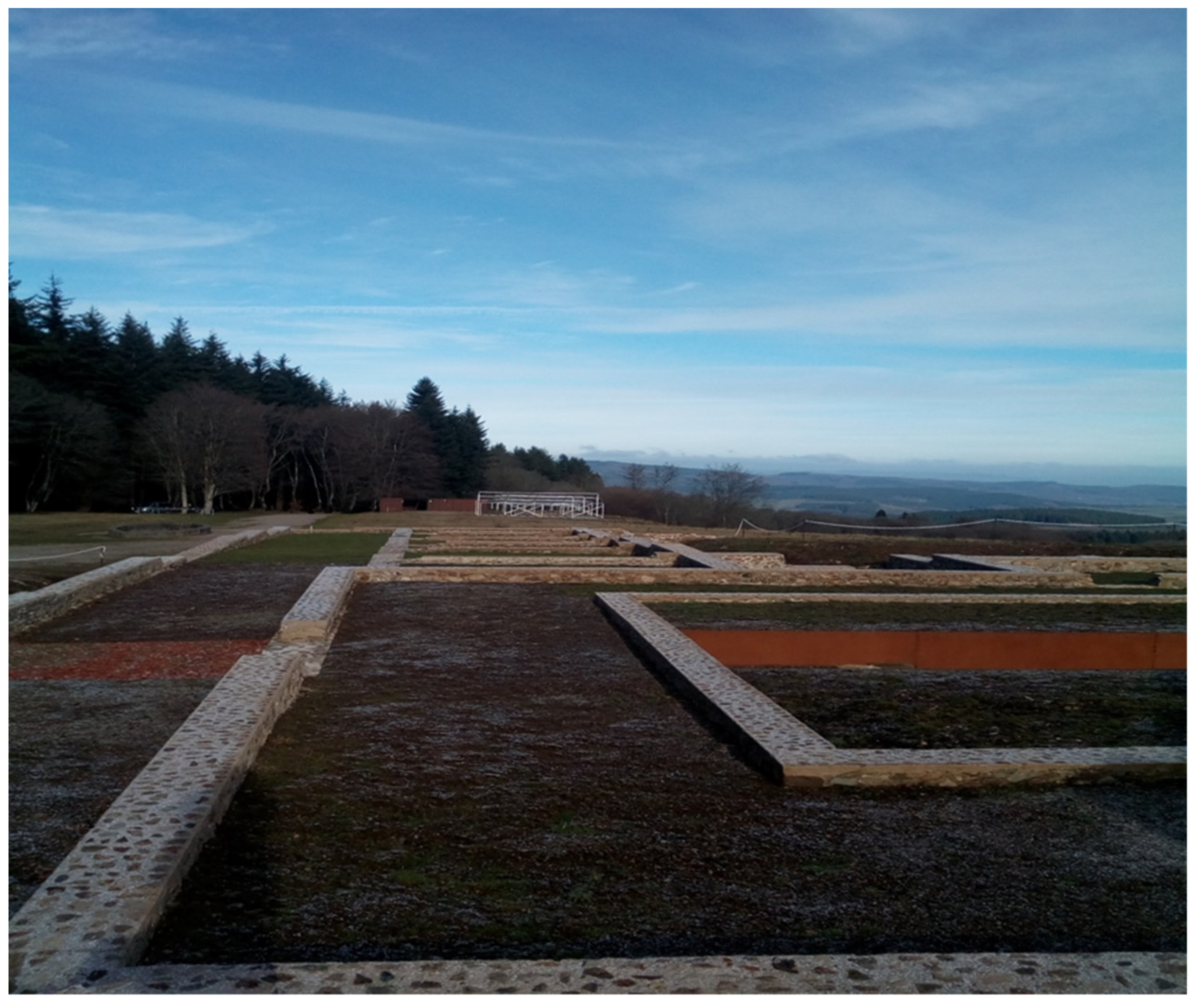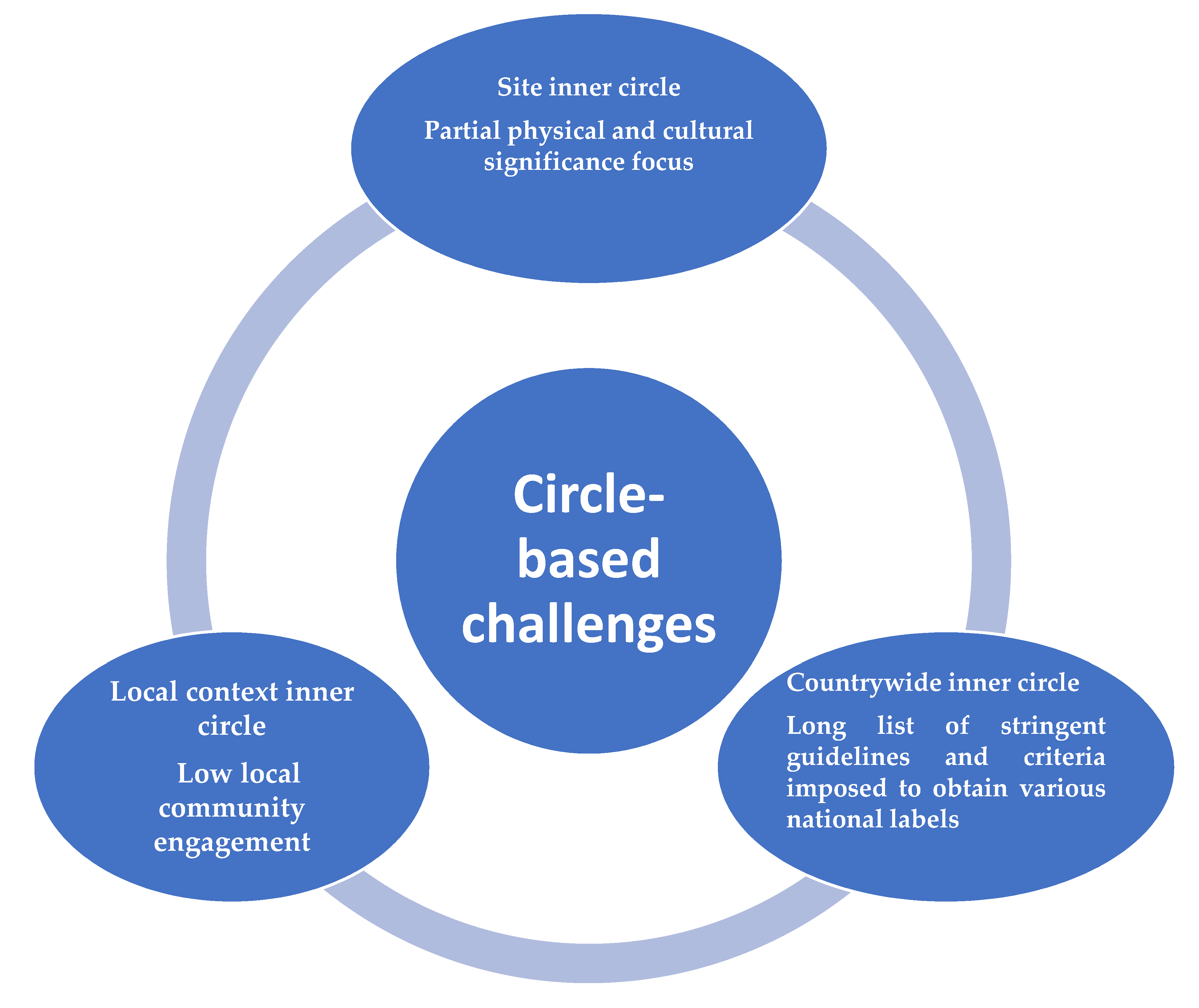Archaeological Sites’ Management, Interpretation, and Tourism Development—A Success Story and Future Challenges: The Case of Bibracte, France
Abstract
:1. Introduction
2. Literature Review
3. Materials and Methods
4. Bibracte: The Case Study
5. Analytical Context
Current Situation: Management, Interpretation, and Tourism
6. Findings and Discussion
7. Conclusions
Funding
Institutional Review Board Statement
Informed Consent Statement
Data Availability Statement
Acknowledgments
Conflicts of Interest
References
- Gravari-Barbas, M.; Jacquot, S. Villes Françaises du Patrimoine Mondiale et Tourisme, Protection, Gestion, Valorisation. 2010. Available online: https://chaire-unesco-culture-tourisme.pantheonsorbonne.fr/sites/default/files/inline-files/VILLES_PATRIMOINE_MONDIAL_IREST_CHAIRE_0.pdf (accessed on 1 February 2019).
- Moore, T.; Guichard, V.; Alvarez Sanchs, J. The place of archaeology in integrated cultural landscape management. A case study comparing landscapes with Iron Age oppida in England, France and Spain. J. Eur. Landsc. 2020, 1, 9–28. [Google Scholar] [CrossRef]
- Para, L.; Vourc’h, A. Heritage sites and sustainable tourism as leverage for local development: The grand site de France. P3T Public Policies Territ. 2012, 1, 6. [Google Scholar]
- Greffe, X. Etude Nationale des Retombées Economiques et Sociales du Patrimoine; Ministère de la Culture et de la Communication: Paris, France, 2009.
- Marceau, G.; Metzger, T.; Azoury, N. Gestion territoriale et valorisation du patrimoine: Vers un développement régional durable. Gest. Organ. 2015, 7, 44–56. [Google Scholar]
- Poirier, P. Gestion d’un Patrimoine Culturel en France: État des Lieux et Perspective, Nîmes. Mémoire de Fin D’étude. 2005. Available online: www.iquesta.com/.../Telecharger-Mémoiregestion-d-un-patrimoine-culturel-en-france-etat-des-lieux-et-perspectives-155. (accessed on 15 February 2019).
- Tully, G.; Piai, C.; Rodríguez-Hernández, J.; Delhommeau, E. Understanding Perceptions of Cultural Landscapes in Europe: A Comparative Analysis Using ‘Oppida’ Landscapes. Hist. Environ. Policy Pract. 2019, 10, 198–223. [Google Scholar] [CrossRef]
- Guichard, V. Raconter la Construction des Territoires: Une Nouvelle Mission Pour les Musées D’archéologie. In Une Histoire des Civilisations. Les révolutions de L’archéologie Contemporaine; Demoule, J.-P., Garcia, D., Schna, A., Eds.; La Découverte/Dominique Carré: Paris, France, 2018; pp. 579–583. [Google Scholar]
- Guichard, V. An Example of Integrated Management of a Heritage Site: Bibracte-Mont Beuvray (Burgundy, France). In Less More Architecture Design Landscape. Le Vie dei Mercanti. X Forum Internazionale di Studi; La Sucuola di Pitagora: Napoli, Italy, 2012. [Google Scholar]
- Rahman, S. Heritage management challenges in historic town of Ludlow, England. World Appl. Sci. J. 2013, 24, 1589–1596. [Google Scholar]
- Jean, J.S.; Joseph, M.; Louis, C.; Michel, J. Haitian Archaeological Heritage: Understanding Its Loss and Paths to Future Preservation. Heritage 2020, 3, 733–752. [Google Scholar] [CrossRef]
- Yilmaz, Y.; Rehab, E.L. Cultural Heritage Management in Turkey and Egypt: A Comparative Study. Adv. Hosp. Tour. Res. 2018, 6, 68–91. [Google Scholar] [CrossRef]
- -Fatorić, S.; Egberts, L. Realising the potential of cultural heritage to achieve climate change actions in the Netherlands. J. Environ. Manag. 2020, 274, 111107. [Google Scholar] [CrossRef]
- Du Cros, H.; Yok-shiu, F.L. (Eds.) Cultural Heritage Management in China: Preserving the Cities of the Pearl River Delta; Routledge: London, UK, 2017. [Google Scholar]
- Hodder, I. Archaeological Theory Today; Polity Press: Cambridge, UK, 2012. [Google Scholar]
- Messenger, P.M.; Smith, G. Cultural Heritage Management. A Global Perspective; University Press of Florida: Gainesville, FL, USA, 2010. [Google Scholar]
- Mangialardi, G.; Corallo, A.; Esposito, M.; Fortunato, L.; Monastero, A.; Schina, L. An integrated and networked approach for the cultural heritage lifecycle management. Encatc. J. Cult. Manag. Policy 2016, 1, 80–95. [Google Scholar]
- Timothy, D. Making sense of heritage tourism: Research trends in a maturing field of study. Tour. Manag. Perspect. 2018, 25, 177–180. [Google Scholar] [CrossRef]
- Willems, A.; Thomas, S.; Castillo Mena, A.; Čeginskas, V.; Immonen, V.; Kalakoski, I.; Mazel, A.D. Teaching Archaeological Heritage Management. Towards a Change in Paradigms. Conserv. Manag. Archaeol. Sites 2018, 20, 297–318. [Google Scholar] [CrossRef]
- Vecco, M. A definition of cultural heritage: From the tangible to the intangible. J. Cult. Herit. 2010, 11, 321. [Google Scholar] [CrossRef]
- Borowiecki, K.J.; Forbes, N.; Fresa, A. Cultural Heritage in a Changing World; Springer: Berlin/Heidelberg, Germany, 2016. [Google Scholar]
- Ross, D.; Saxena, G.; Correia, F.; Deutz, P. Archaeological tourism: A creative approach. Ann. Tour. Res. 2017, 1, 37–47. [Google Scholar] [CrossRef]
- Bandarin, F.; Van Oers, R. The Historic Urban Landscape Managing Heritage in Urban Century, 1st ed.; John Wiley & Sons: Hoboken, NJ, USA, 2012. [Google Scholar]
- De la Torre, M. Values and heritage conservation. Herit. Soc. 2013, 6, 155–166. [Google Scholar] [CrossRef]
- Doumas, C.G. Managing the archaeological heritage: The case of Akrotiri, Thera (Santorini). Conserv. Manag. Archaeol. Sites 2013, 15, 109–120. [Google Scholar] [CrossRef]
- Magliacani, M. Managing Cultural Heritage: Ecomuseums, Community Governance, Social Accountability; Springer: Berlin/Heidelberg, Germany, 2014. [Google Scholar]
- Manning, R. Visitor experience and resource protection: A framework for managing the carrying capacity of National Parks. J. Park Recreat. Adm. 2001, 19, 93–108. [Google Scholar]
- Enseñat-Soberanis, F.; Frausto-Martínez, O.; Gándara-Vázquez, M. A visitor flow management process for touristified archaeological sites. J. Herit. Tour. 2019, 14, 340–357. [Google Scholar] [CrossRef]
- Ahmad, Y. The Scope and Definitions of Heritage. Int. J. Herit. Stud. 2006, 12, 292–300. [Google Scholar] [CrossRef]
- Makuvaza, S. (Ed.) Aspects of Management Planning for Cultural World Heritage Sites: Principles, Approaches and Practices; Springer: Berlin/Heidelberg, Germany, 2017. [Google Scholar]
- Sullivan, S. A Planning Model for the Management of Archaeological Sites. In The Conservation of Archaeological Sites in the Mediterranean Region; de la Torre, M., Ed.; The Getty Conservation Institute: Los Angeles, CA, USA, 1997; pp. 15–26. [Google Scholar]
- Feilden, B.M.; Jokilehto, J. Management Guidelines for World Cultural Heritage Sites; ICCROM: Rome, Italy, 1998. [Google Scholar]
- Stovel, H. Risk Preparedness: A Management Manual for World Cultural Heritage; ICCROM: Rome, Italy, 1998. [Google Scholar]
- The Burra Charter (The Australia ICOMOS Charter for Places of Cultural Significance). 1999. Available online: http://openarchive.icomos.org/id/eprint/2145/ (accessed on 22 August 2021).
- Demas, M. Planning for Conservation and Management of Archaeological Sites. In Management Planning for Archaeological Sites; Teutonico, J.M., Palumbo, G., Eds.; The Getty Conservation Institute: Los Angeles, CA, USA, 2002; pp. 27–54. [Google Scholar]
- Ringbeck, B. Management Plans for World Heritage Sites. A Practical Guide; German Commission for UNESCO: Bonn, Germany, 2008. [Google Scholar]
- Cleere, H. Management plans for archaeological sites: A world heritage template. Conserv. Manag. Archaeol. Sites 2010, 12, 4–12. [Google Scholar] [CrossRef]
- Mason, R. Assessing Values in Conservation Planning: Methodological Issues and Choices. In Assessing the Values of Cultural Heritage: Research Report; de la Torre, M., Ed.; The Getty Conservation Institute: Los Angeles, CA, USA, 2003; pp. 5–30. [Google Scholar]
- Ababneh, A. Heritage Management and Interpretation: Challenges to Heritage Site-Based Values, Reflections from the Heritage Site of Umm Qais, Jordan. Archaeologies 2016, 12, 38–72. [Google Scholar] [CrossRef]
- Avrami, E.; Macdonald, S.; Mason, R.; Myers, D. (Eds.) Values in Heritage Management: Emerging Approaches and Research Directions; Getty Conservation Institute: Los Angeles, CA, USA, 2019. [Google Scholar]
- Den, W. Community empowerment and heritage conservation: The experience of Beitou District in Taipei City, Taiwan. Hist. Environ. Policy Pract. 2014, 5, 258–274. [Google Scholar] [CrossRef]
- Polyzoudi, A. Archaeological Heritage as Palimpsest. The Multiple Layers of Contents of a Byzantine Tower and the Challenges of Sustainable Management Planning. Hist. Environ. Policy Pract. 2013, 4, 129–138. [Google Scholar] [CrossRef]
- Poulios, I. Discussing strategy in heritage conservation: Living heritage approach as an example of strategic innovation. J. Cult. Herit. Manag. Sustain. Dev. 2014, 4, 16–34. [Google Scholar] [CrossRef]
- Taylor, K.; Lennon, J. (Eds.) Managing Cultural Landscapes; Routledge: London, UK, 2012. [Google Scholar]
- Imon, S.S.; Ong, C.E. Cultural Tourism Site Management: A Training Manual for Trainers in the Greater Mekong Sub-Region; United Nations Economic and Social Commission for Asia and the Pacific (UNESCAP) and Institute For Tourism Studies (IFT): Macao, China, 2007. [Google Scholar]
- Ababneh, A. Situational Analysis of Archaeological Site’s Interpretation Based on Examples from Jordan. Archaeologies 2017, 13, 278–305. [Google Scholar] [CrossRef]
- Kausar, D.R.; Nishikawa, Y. Heritage tourism in rural areas: Challenges for improving socio-economic impacts. Asia Pac. J. Tour. Res. 2010, 15, 195–213. [Google Scholar] [CrossRef]
- Kim, S.; Lee, H. Visitor attention and communication in information based exhibitions. Int. J. Des. 2016, 10, 15–30. [Google Scholar]
- Ababneh, A. The Site of Pella in Jordan: A Case Study for Developing Interpretive Strategies in an Archaeological Heritage Attraction. Near East. Archaeol. 2018, 81, 100–107. [Google Scholar] [CrossRef]
- Hodges, S. Building Peace: The Role of Heritage Interpretation. Public History. 2019. Available online: https://epress.lib.uts.edu.au/journals/index.php/phrj/article/view/6853 (accessed on 17 July 2021).
- Beck, L.; Cable, T.T.; Knudson, D.M. Interpreting Cultural and Natural Heritage: For a Better World; Sagamore Publishing: Champaign, IL, USA, 2018. [Google Scholar]
- Wyatt, B.; Leask, A.; Barron, P. Designing dark tourism experiences: An exploration of edutainment interpretation at lighter dark visitor attractions. J. Herit. Tour. 2010, 1–17. [Google Scholar]
- Hvenegaard, G.T. Visitors’ perceived impacts of interpretation on knowledge, attitudes, and behavioral intentions at Miquelon Lake Provincial Park, Alberta, Canada. Tour. Hosp. Res. 2017, 17, 79–90. [Google Scholar] [CrossRef]
- Brochu, L.; Merriman, T. Redefining interpretation as a core belief for certification of professionals. J. Intepretation Res. 2002, 7, 11–16. [Google Scholar] [CrossRef]
- Li, H.; Qian, Z. Archaeological heritage tourism in China: The case of the Daming Palace from the tourists’ perspective. J. Herit. Tour. 2017, 12, 380–393. [Google Scholar] [CrossRef]
- World Tourism Organization. Tourism and Culture Synergies; UNWTO: Madrid, Spain, 2018. [Google Scholar]
- Zhang, C.; Fyall, A.; Zheng, Y. Heritage and tourism conflict within world heritage sites in China: A longitudinal study. Curr. Issues Tour. 2015, 18, 110–136. [Google Scholar] [CrossRef]
- Alazaizeh, M.M.; Jamaliah, M.M.; Mgonja, J.T.; Ababneh, A. Tour guide performance and sustainable visitor behavior at cultural heritage sites. J. Sustain. Tour. 2019, 27, 1708–1724. [Google Scholar] [CrossRef]
- Cho, M.; Shin, S. Conservation or economization? Industrial heritage conservation in Incheon, Korea. Habitat Int. 2014, 41, 69–76. [Google Scholar] [CrossRef]
- Timothy, D. Introduction. In Managing Heritage and Cultural Tourism Resources; Timothy, D.J., Ed.; Routledge: Abingdon, UK, 2016; pp. 11–14. [Google Scholar]
- Zan, L. Cultural Heritage in China: Between Policies, Development, Professional Discourse, and the Issue of Managing. Public Archaeol. 2014, 13, 99–112. [Google Scholar] [CrossRef]
- Leask, A. Visitor attraction management: A critical review of research. Tour. Manag. 2016, 57, 334–361. [Google Scholar] [CrossRef]
- Álvarez, M.P. Conservation Realities and Challenges at Archaeological and Historical Sites in Colombia: Seeking Success by Considering the Context. In Objects Specialty Group Postprints, Volume Twenty-One; Davis, S., Ed.; The American Institute for Conservation of Historic & Artistic Works: Washington, DC, USA, 2014; pp. 323–344. [Google Scholar]
- Kausar, D.R.K.; Gunawan, M.P. Managing heritage tourism in Toraja: Strengthening local values and improving tourists’ experiences. J. Herit. Tour. 2017, 13, 550–561. [Google Scholar] [CrossRef]
- Rotherham, I.D.; Ardron, P.A. The archaeology of woodland landscapes: Issues for managers based on the case-study of Sheffield, England and four thousand years of human impact. Arboric. J. 2006, 29, 229–243. [Google Scholar] [CrossRef]
- McKercher, B.; Du Cros, H. Cultural Tourism: The Partnership between Tourism and Cultural Heritage Management; Routledge: London, UK, 2002. [Google Scholar]
- Bhati, A.; Pearce, P. Vandalism and tourism settings: An integrative review. Tour. Manag. 2016, 57, 91–105. [Google Scholar] [CrossRef]
- Högberg, A.; Holtorf, C.; May, S.; Wollentz, G. No future in archaeological heritage management? World Archaeol. 2017, 49, 639–647. [Google Scholar] [CrossRef] [Green Version]
- Baxter, I. From heritage to historic environment: Professionalizing the experience of the past for visitors. J. Hosp. Tour. 2004, 2, 1–14. [Google Scholar]
- Pattin, V. Tourisme et Patrimoine en France et en Europe; La Documentation Française: Paris, France, 1997. [Google Scholar]
- Bramwell, B.; Meyer, D. Power and tourism policy relations in transition. Ann. Tour. Res. 2007, 34, 766–788. [Google Scholar] [CrossRef]
- Romero, A.M.; Maillier, A. Bibracte: Archéologie D’une Ville Gauloise; Bibracte, Centre Archéologique Européen: Glux-en-Glenne, France, 2006. [Google Scholar]
- Guichard, V.; Chazelle, C. Mettre en Valeur L’invisible: Réflexions sur le Site Archéologique de Bibracte. In De la Restitution en Archéologie, Actes du Colloque de Béziers (Octobre 2005); Bellet, M.-E., Chazelle, C.L., Eds.; Centre des Monuments Nationaux: Paris, France, 2007; pp. 179–186. Available online: http://editions.monuments-nationaux.fr (accessed on 4 April 2019).
- Chazelle, C. Bibracte Mont-Beuvray. Gestion du Grand Site et de ses Territoires. Elements de Diagnostic Paysager; Clermont-Ferrand: Atelier Claude Chazelle. 2017. Available online: http://www.bibracte.fr/media/bibracte/163210-2017_chazelle_diagnostic_paysager.pdf (accessed on 1 June 2021).
- Bibracte. Available online: www.bibracte.fr (accessed on 1 June 2021).
- Lemarchand, F.; Maillier, A. Bibracte: Une Ville Entre Deux Mondes; CAE Européen Mont-Beuvray: Glux-en-Glenne, France, 2017. [Google Scholar]
- Tabardy, D.; Maillier, A. Bibracte—Mont Beuvray: Grand Site de France; Les Nouvelles Éditions de l’Université; Petit futé, Beaux Livres/Grand Site de France: Paris, France, 2015. [Google Scholar]
- Chazelle, C.; Guichard, V. Mettre en Valeur L’invisible: Une Réflexion à Propos du Site Archéologique de Bibracte. In Gestion et Présentation des Oppida: Un Panorama Européen, Actes de la Table Ronde de Beroun (CZ), 26 Septembre 2007; Benková, I.I., Guichard, V., Eds.; Institut Archéologique de Bohême Centrale: Beroun, Czech Republic, 2008; pp. 179–186. [Google Scholar]
- Ayalew, K. Heritage Management on the Ground Heritage Conservation Versus Local Community in Lalibela (Ethiopia). Master’s Thesis, Universidade de Évora, Paris, France, 2016. [Google Scholar]
- Hughes, M.; Carlsen, J. The business of cultural heritage tourism: Critical success factors. J. Herit. Tour. 2010, 5, 17–32. [Google Scholar] [CrossRef] [Green Version]




| Item | Description and Details |
|---|---|
| Governance | It is an autonomous public-run site managed byBibracte EPCC (Etablissement public de cooperation cultural) |
| Legislative framework | The law of 1913 creating the index of registered historical monuments (monuments historiques classés). The law of 1930 creating the index of registered scenic places and landscapes (sites classés).The Code du Patrimoine (Code of Patrimony)and the Code de l’Environnement (Code of the Environment), |
| Financial resources | Financial autonomy, with a total annual budget of more than EUR 4 million |
| Human expertise | Human resources work in three departments, including the resource section, the cultural section, and the scientific section. |
| Planning system/management policy | Adopting the policy of the Grands Sites de France, which relies on local authorities and integrated management methods. |
| Branding and labels | The site was declared as one of the Grands Sites de France in 2007, a National HistoricMonument in 1984, a special natural conservation zone 2000, and a fragile landscape buffer zone. |
| Gallery | Themes | Subthemes | Interpretive Tools |
|---|---|---|---|
| The upper gallery | Iron Age urbanism phenomena of Bibracte and Europe | - A well-ordered rural landscape - A shift in scale - A century-long lifespan - Spanning the content - A complex society - From myth to history | Brochures, dioramas, maps, models, labels, signs, posters, videos, films, narrations, testimonies, audiovisual shows, data shows, touchscreens, modeled excavations, modeled houses, archaeological material, tour guides, guided tours, self-guided tours, audio guides, web site, social media graphic models, digital mock-up, books, research articles, magazines, newsletters, training and educational events |
| The lower gallery | Archaeological evidence and historical development | - In the footsteps of Caesar - An urban building plan - A town in the ascendant - Consumption and production - The inhabitants of the oppidum - The transfer of the capital | Brochures, dioramas, maps, models, labels, signs, posters, videos, films, narrations, testimonies, audiovisual shows, data shows, touchscreens, modeled excavations, modeled houses, archaeological material, tour guides, guided tours, self-guided tours, audio guides, web site, social media, books, graphic models, digital mock-up, research articles, magazines, newsletters, training and educational events |
| Item | Description Details |
|---|---|
| Tourism resources | Archaeological monuments, museum, historic landscape, handicrafts, souvenir products, historic events, traditional events, traditional cuisine, traditions and customs, rural landscape, rivers, agricultural lands and products |
| Tourism potential | Heritage tourism, rural tourism, ecotourism, adventure tourism |
| Services and amenities | Accommodation, restaurants, museum, research center, visitor center, souvenir shop, library |
| Visitors to the site | Locals and Europeans, families, students, young couples |
| Visits and activities | Sightseeing, walking, touring, cultural visits, guided and non-guided visits, school visits, excavation training programs |
| Accesibility | Bibracte is a long way from any major urban centers or cities, and cannot be reached by motorway or train |
Publisher’s Note: MDPI stays neutral with regard to jurisdictional claims in published maps and institutional affiliations. |
© 2021 by the author. Licensee MDPI, Basel, Switzerland. This article is an open access article distributed under the terms and conditions of the Creative Commons Attribution (CC BY) license (https://creativecommons.org/licenses/by/4.0/).
Share and Cite
Ababneh, A. Archaeological Sites’ Management, Interpretation, and Tourism Development—A Success Story and Future Challenges: The Case of Bibracte, France. Heritage 2021, 4, 2261-2277. https://doi.org/10.3390/heritage4030128
Ababneh A. Archaeological Sites’ Management, Interpretation, and Tourism Development—A Success Story and Future Challenges: The Case of Bibracte, France. Heritage. 2021; 4(3):2261-2277. https://doi.org/10.3390/heritage4030128
Chicago/Turabian StyleAbabneh, Abdelkader. 2021. "Archaeological Sites’ Management, Interpretation, and Tourism Development—A Success Story and Future Challenges: The Case of Bibracte, France" Heritage 4, no. 3: 2261-2277. https://doi.org/10.3390/heritage4030128
APA StyleAbabneh, A. (2021). Archaeological Sites’ Management, Interpretation, and Tourism Development—A Success Story and Future Challenges: The Case of Bibracte, France. Heritage, 4(3), 2261-2277. https://doi.org/10.3390/heritage4030128






